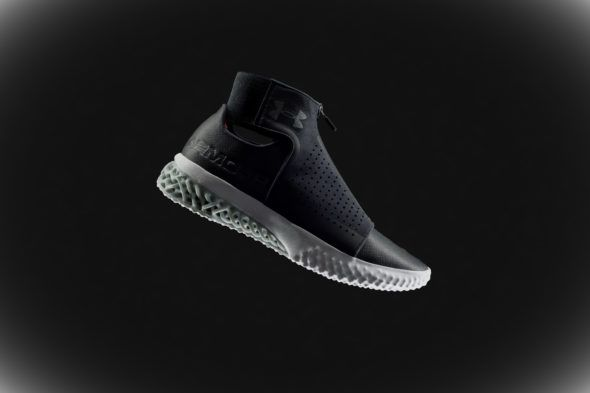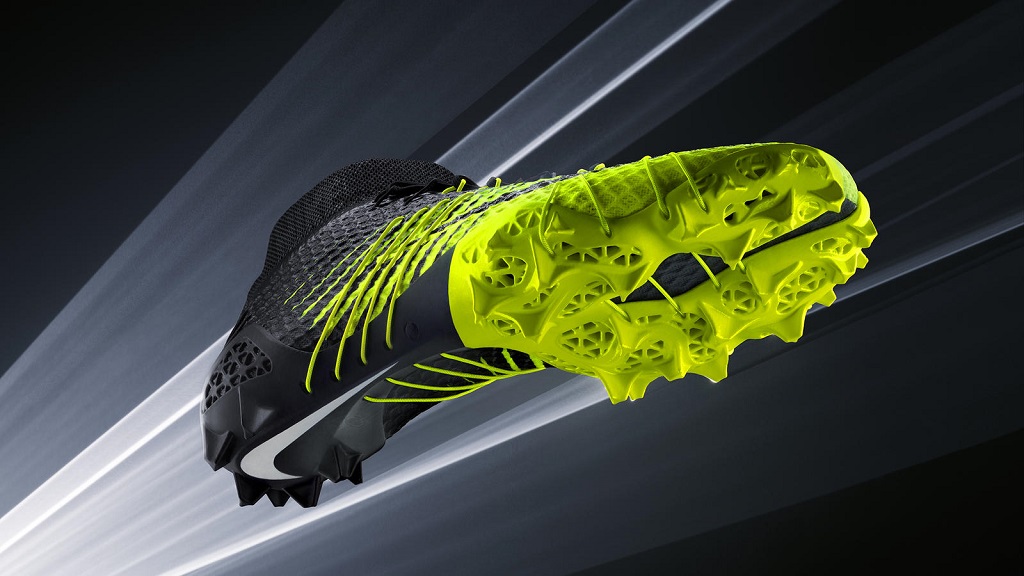
Charles Goulding, Tyler Gianchetta, and Andressa Bonafe take a look at 3D printing in innovative apparel.
3D printing has made its presence felt across the manufacturing industry in a myriad of applications. With new technology and innovations being introduced, the world of apparel is now experiencing these innovations firsthand. Household brand names like Under Armour and Nike are wholeheartedly embracing the new technological advances to push the boundaries of design and functionality.
Under Armour
Under Armour has fully embraced 3D printing as a pivotal part of their apparel manufacturing processes. Despite already being a household name, the global juggernaut continues to explore potential methods to refine their products and processes. In order to facilitate these innovations, Under Armour has partnered with the 3D printing company EOS to help bring 3D-printed sneakers to market. Utilizing highly advanced laser sintering technology, Under Armour and EOS have steadily worked towards the goal of industrializing and scaling 3D printing performance footwear.

The recent partnership further exemplifies Under Armour’s dedicated efforts to add technology to its already extensive selection of traditional apparel, accessories, and footwear. In addition to implementing EOS technology in the production of powder-based parts for footwear, Under Armour is also working in conjunction with EOS Additive Minds to develop new polymer-based materials that can be utilized alongside the laser sintering technology, in an effort to expand the scope of 3D printing in more of Under Armour’s products.
Along with enabling the company to scale the manufacturing side of the business more efficiently, the advent of 3D printing has also allowed Under Armour to introduce a new line of direct-to-consumer connected fitness products that can assist users during physical workouts. While connected fitness is still a relatively small portion of Under Armour’s total business revenue, it has experienced a rapid growth rate over the past year and signifies a new focal point for the company that has consistently been centered on using technology to enhance its products and manufacturing processes.
Nike
Nike has also embraced the impact of 3D printing technology as a catalyst in the continued evolution of their business. In 2016, they announced a partnership with the multinational IT company HP Inc. as a demonstration of their efforts to integrate new methodologies into their products and processes. The move is the culmination of over three years of innovation in the 3D printing and Selective Laser Sintering (SLS) area, which has allowed Nike to exponentially accelerate the development of prototypes, completing them in mere hours rather than months. The implementation of these strategies has also fast-tracked the inception of high-performance products such as the Nike Vapor Laser Talon and Nike Vapor HyperAgility, two football cleats developed using 3D printing technology that provide several niche benefits compared to standard cleats.
The Nike Vapor Laser Talon weighs only 5.6 ounces and provides optimal traction on football turf in addition to helping athletes maintain their “drive stance” longer, making these cleats perfect for the 40-yard dash and mastering the “Zero Step”. The Zero Step is one of the most – if not the most – crucial element to achieving a fast time on the 40, as the athlete’s propulsion and acceleration rate are determined in the moments before the initial step even hits the turf. The specifications of the 3D printed plate have been optimized in such a way that allows the wearer to maintain their drive position longer and more efficiently, helping them accelerate faster through the first 10 yards of the 40-yard dash, which can make or break the entire run.
![Nike Vapor Laser Talon [Source: Nike]](https://fabbaloo.com/wp-content/uploads/2020/05/Apparel-Image2_img_5eb09e5110efe.png)
Nike has continued to push the boundaries of innovation with the debut of the Nike Vapor HyperAgility in 2014. Where the Laser Talon was designed to excel in the 40-yard dash, the Nike Vapor HyperAgility Cleat has been specially built for the 5-10-5, also commonly known as the “shuttle drill” or “that one exercise at the end of every high school practice that always got a collective groan from the team”.
Contrary to the 40-yard dash which gauges an athlete’s linear speed and acceleration, the shuttle drill is designed to test an athlete’s agility and lateral ability to change direction quickly. Using 3D printing processes, Nike was able to design the HyperAgility Cleat with these factors in mind. The HyperAgility Cleats (see image at top of article) provide optimal traction on turf and traction confidence as well as reduce the time required to decelerate and change directions. The unique design of the cleat also yields significantly higher acceleration rates coming out of the turn, allowing the wearer to move in short incremental bursts without the perceived need to slow down between cuts.
3D printing has allowed Nike to test, iterate, and create cutting-edge products that would otherwise be impossible to develop using conventional means. In addition to footwear, Nike has also been utilizing 3D printed textiles such as Flyprint. The development process of the Flyprint uppers includes capturing and computing the athlete data to determine the ideal composition of the material. This information is then employed to produce the final textile, which demonstrates Flyprint’s immense versatility as the final output can be made unique to the athlete or the functionality at a significantly higher overall design pace.
By utilizing performance 3D printing, Nike is capable to prototyping 16 times faster than with any other previous manufacturing. Another benefit that 3D textiles provide over traditional fabrics is the increased dynamism made possible due to the fused nature of the material. For example, while a knit or woven textile will have frictional resistance between the interlaced yarns, printed textiles possess greater potential for precision-tuned containment due to the fused intersections. The Flyprint textiles are also lighter and more breathable than any of Nike’s previously employed textiles. Rapid iteration makes testing and revision cycle times substantially faster.
The Research & Development Tax Credit
R&D tax credits are available to support apparel companies that take advantage of additive manufacturing to create new and improved products and processes.
Enacted in 1981, the now permanent Federal Research and Development (R&D) Tax Credit allows a credit that typically ranges from 4%-7% of eligible spending for new and improved products and processes. Qualified research must meet the following four criteria:
-
Must be technological in nature
-
Must be a component of the taxpayer’s business
-
Must represent R&D in the experimental sense and generally includes all such costs related to the development or improvement of a product or process
-
Must eliminate uncertainty through a process of experimentation that considers one or more alternatives
Eligible costs include U.S. employee wages, cost of supplies consumed in the R&D process, cost of pre-production testing, U.S. contract research expenses, and certain costs associated with developing a patent.
On December 18, 2015, President Obama signed the PATH Act, making the R&D Tax Credit permanent. Beginning in 2016, the R&D credit can be used to offset Alternative Minimum tax for companies with revenue below $50MM and for the first time, pre-profitable and pre-revenue startup businesses can obtain up to $250,000 per year in payroll taxes and cash rebates.
The Way Ahead
Under Armour and Nike have been at the forefront of integrating 3D printing processes into the apparel industry. New concepts are constantly being developed and we can only expect 3D printing to open new markets and promote further growth. As additive manufacturing technology becomes more widely integrated into apparel production processes, new testing protocols and quality control efforts must be introduced. When interviewed for this article Adam Varley of Vartest, the leading NYC apparel testing firm, stated that it is important to always test new apparel utilizing the appropriate tests for the new and or improved products being developed.











